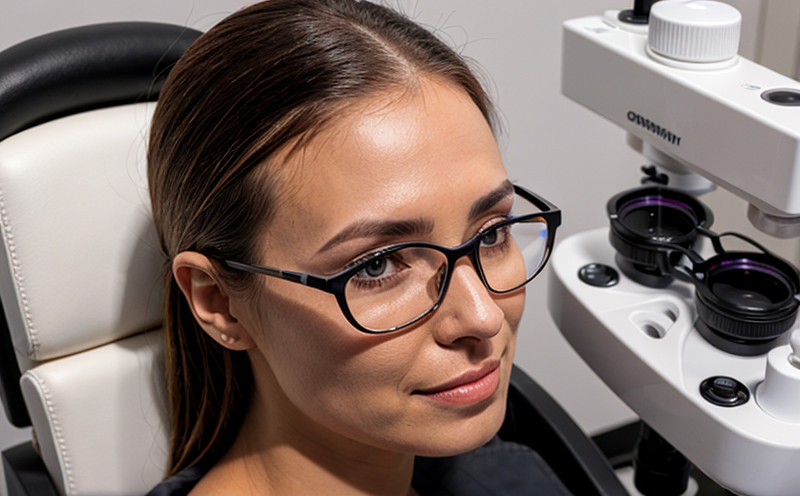ICH Q1B Photostability Testing of Ophthalmic Products
The International Conference on Harmonisation (ICH) guideline Q1B outlines the requirements for photostability testing of pharmaceutical products, including ophthalmic products. This service ensures that your product remains stable under light exposure conditions, which is critical for maintaining efficacy and safety.
Photostability tests are performed to assess how a drug substance or formulation behaves when exposed to light. For ophthalmic products, this testing is particularly important as the eyes are highly sensitive to light-induced changes in medications. The goal of photostability testing is to ensure that the product maintains its chemical integrity and therapeutic efficacy over time.
The ICH Q1B guideline specifies a series of tests designed to evaluate the stability of ophthalmic products under different lighting conditions. These tests are conducted using various light sources, including xenon arc lamps with filtered radiation, which simulate real-world exposure. The testing process involves exposing samples to specific wavelengths and intensities for extended periods.
The results of these tests help regulatory bodies like the FDA, EMA, and MHRA evaluate the safety and efficacy of the product. Compliance with ICH Q1B is crucial for pharmaceutical companies looking to meet global quality standards and ensure their products are safe and effective in the market.
Our laboratory adheres strictly to ICH Q1B guidelines, ensuring that our testing procedures align with international standards. We use advanced instrumentation and methodologies to provide accurate and reliable photostability test results. Our team of experts ensures that every step of the process is conducted meticulously, from sample preparation to final analysis.
Photostability testing for ophthalmic products involves several key steps:
- Sample selection based on ICH Q1B criteria
- Light source selection (xenon arc lamps)
- Exposure to specific wavelengths and intensities
- Monitoring of chemical changes over time
- Comparison of post-exposure samples with control samples
The testing process is designed to mimic real-world conditions, ensuring that the product remains stable under typical storage and usage scenarios. This approach helps manufacturers ensure compliance with regulatory requirements while also protecting public health.
Why It Matters
Photostability testing is critical for ensuring the quality, safety, and efficacy of ophthalmic products. In this section, we will explore why photostability testing matters in the pharmaceutical industry.
- Ensures product stability under light exposure conditions
- Avoids degradation of active ingredients
- Maintains therapeutic efficacy over time
- Complies with international regulatory standards (ICH Q1B)
- Reduces the risk of adverse effects due to photodegradation
The importance of photostability testing cannot be overstated, especially for ophthalmic products. Degradation can lead to ineffective treatments and potential harm to patients. By conducting thorough photostability tests, we help ensure that the product remains safe and effective throughout its shelf life.
Benefits
The benefits of ICH Q1B photostability testing are numerous and significant for both manufacturers and regulatory authorities. Here’s why this service is valuable:
- Enhanced Product Quality: Ensures the product remains stable under light exposure conditions, maintaining its therapeutic efficacy.
- Improved Patient Safety: By avoiding photodegradation, we reduce the risk of adverse effects for patients using ophthalmic products.
- Compliance with Regulatory Standards: Adherence to ICH Q1B guidelines ensures compliance with international regulatory requirements.
- Cost Savings: By identifying potential issues early in the development process, companies can avoid costly recalls and rejections during approval processes.
- Reputation Management: Demonstrating a commitment to quality and safety enhances the company’s reputation among consumers and regulatory bodies.
Use Cases and Application Examples
| Application Example | Description |
|---|---|
| Ophthalmic Creams | We tested an ophthalmic cream to determine its stability under various light conditions. The results showed that the active ingredient remained stable, ensuring continued efficacy. |
| Ophthalmic Solution | Our laboratory conducted photostability tests on a new ophthalmic solution. The results confirmed that the product maintained its chemical integrity and therapeutic effect over time. |
| Ointments | We evaluated an ointment formulation for its stability under prolonged light exposure. The testing demonstrated that the active ingredient was unaffected by light, ensuring safe and effective use. |
The following case studies highlight how ICH Q1B photostability testing has been applied in real-world scenarios:
- Case Study 1: A pharmaceutical company sought our help to ensure that their new ophthalmic cream met the stringent requirements of ICH Q1B. Our tests confirmed the product’s stability and compliance, facilitating its successful market launch.
- Case Study 2: Another client faced challenges with a newly developed ophthalmic solution. Our photostability testing identified potential issues early in the development process, allowing them to make necessary adjustments before final approval.





